╔
Venice’s natural element is water, but its most illustrious citizen travelled by land. It was in 1271 that a young man named Marco Polo left Northern Italy for China to accompany his father on a trading expedition. The long journey to the East, on the so-called “Silk Road”, lasted more than three years due to bad weather, wars, and disease, whereas his stay in Asia was 25 years long: during this period of time, the Venetian young man was able to win the Mongol Emperor’s trust to such an extent that he became one of his most trusted advisor and high officials.

Zoran Mušič, History of Marco Polo, 1951. (© Matteo de Fina, 2024).
Born in Venice in 1254 into a family of merchants, Marco Polo certainly is one of the best-known figures in the history of the Serenissima. With his extraordinary exploits between reality and myth, which are narrated in the book known in Italian as “Il Milione” (in English is commonly referred to as “The Travels of Marco Polo”), he gave the first reliable and complete account of the East, and the first contribution to mutual understanding between Asia and Europe. In particular, the book gave an accurate description not only of China and the Asian continent, but also, and for the first time, of the vast world of islands, from Japan to Madagascar.
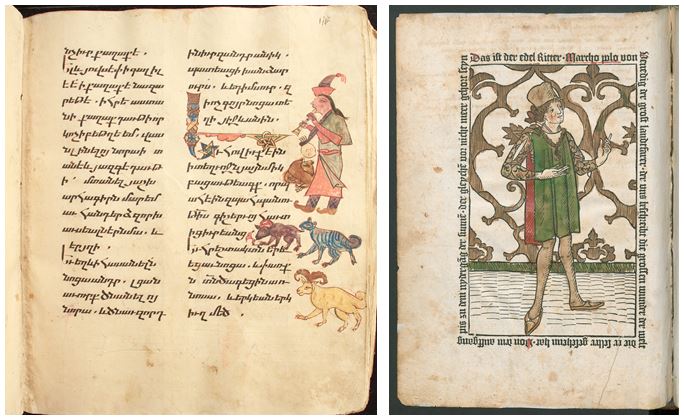
Jakob, Gospel (left). Marco Polo, Devisement dou monde, vérsion LA, German translation, printed edition; Das Puch des edelen Ritters und Landtfarers Marcho Polo, Nuremberg, Friedrich Creussner (right).
Marco Polo’s journey alongside his father and uncle began in Venice and spanned across Turkey, Persia, Afghanistan, and the Gobi Desert. In 1275, the three travelers arrived in Katai, a region in Northern China, part of the Grand Khan of the Mongols. The Great Khan Kublai, the Mongol emperor who at the time was ruling over China, considered Marco well-versed in languages and a brilliant young man: it was for this reason that he decided to entrust the Venetian with the task of managing the administration in various parts of his Empire.
After living seventeen years in China and another six or seven travelling across the world known at the time, Marco Polo returned to Venice. It was in 1295 and he was 40 years old. Shortly afterwards, while taking part in a naval battle between the Maritime Republics of Venice and Genoa, he was held prisoner by the enemies of the Serenissima. It was on this occasion that he recounted his memoirs to Rustichello da Pisa, an Italian romance writer. This was the birth of “Il Milione“, a masterpiece of travel literature and one of the first geographic encyclopedia, a geographical and historical treatise, a book of exploration which, for its relevance, is still considered a pillar of Italian literature. Marco Polo’s “Il Milione” has come a long way, and will continue to do so, because scholars have not yet finished studying its many curiosities.
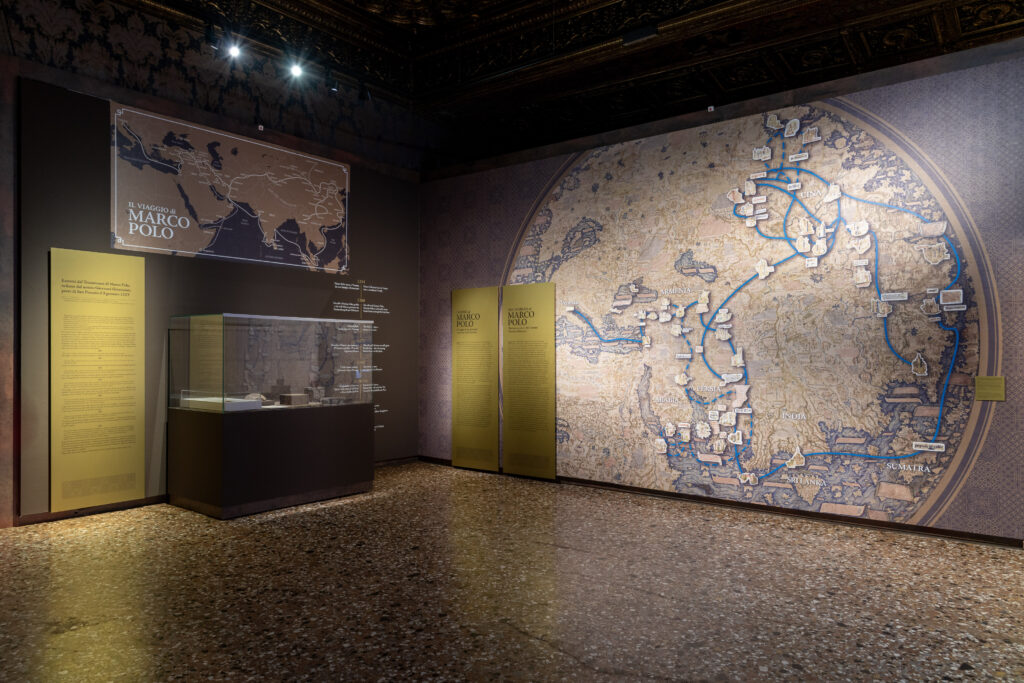
One of the first rooms of the exhibition “The worlds of Marco Polo. The journey of a 13th-century Venetian merchant” at the Doge’s Palace in Venice. (© Photo: Irene Fanizza, 2024).
To him, the Venetian traveler par excellence, on the 700th anniversary of his death, occurred on the 8th of January 1324, the City of Venice dedicates a year of widespread events. A cultural wealth of great educational and disseminative value will be the protagonist throughout 2024 with exhibitions, meetings, and in-depth studies for everyone, with particular attention to the new generations.
Celebrating Marco Polo and his travels 700 years after his death presents an opportunity to recount his unparalleled life, his thirst for knowledge, his drive to explore, his desire to discover new perspectives and other ways of living and, above all, to share all this.
Among these initiatives, one of the most remarkable is the important exhibition held at the Doge’s Palace entitled “I mondi di Marco Polo. Il viaggio di un mercante Veneziano del Duecento” (The worlds of Marco Polo. The journey of a 13th-century Venetian merchant).
An exhibition, organized as part of the initiatives promoted by the Municipality of Venice and the National Committee for the Celebrations of the 700th anniversary of the death of Marco Polo, and carried out with the collaboration of the Ca’ Foscari University in Venice and the Italian Cultural Institute of Shanghai, to celebrate, rethink and reveal Marco Polo: his time, his life, his work, his journey, his example and his legacy.
Display cases at the exhibition in the Doge’s Palace, Venice. (© Photo: Irene Fanizza, 2024).
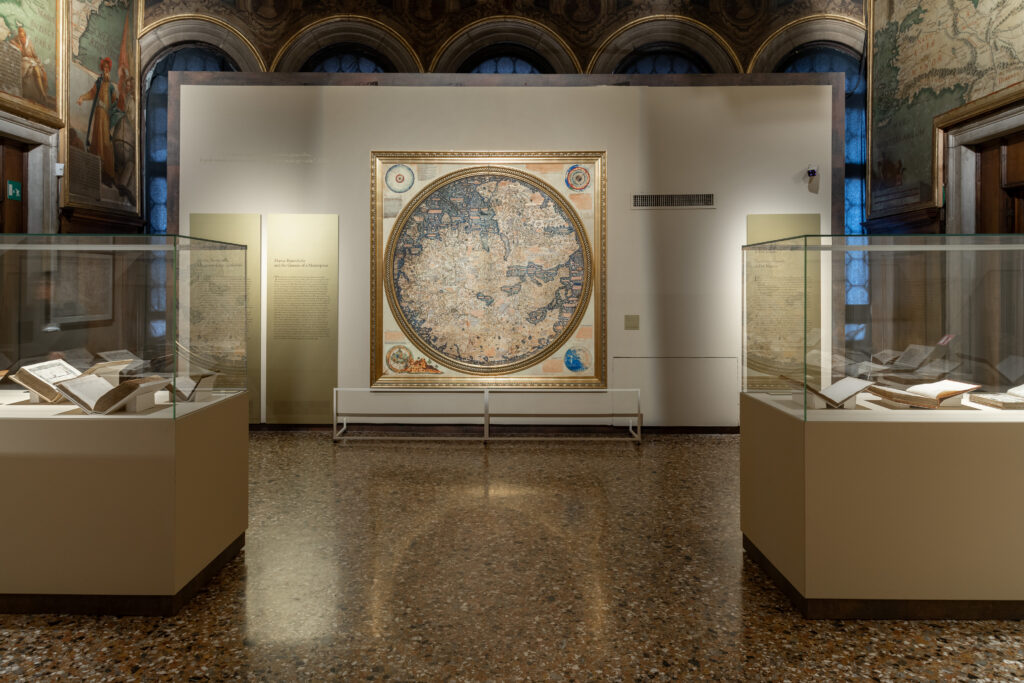
Display cases at the exhibition in the Doge’s Palace, Venice. (© Photo: Irene Fanizza, 2024).
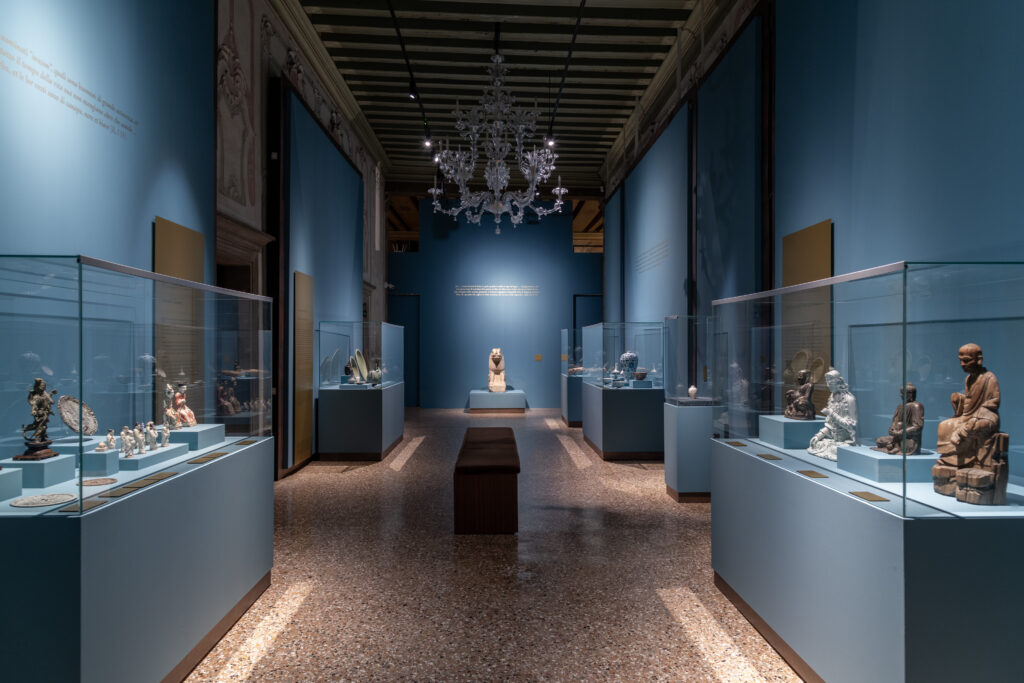
A man, a citizen of the world by virtue of being born in Venice, the city that bridged the gap between East and West, rendering the distant and unknown more accessible. This is the aim of the exhibition open until September 29, 2024, at the Doge’s Palace. It represents a tribute to the man but, above all, reveals a desire to share what he described in his literary work Il Milione: an inexhaustible source of inspiration for scholars, explorers, and travelers of all ages.
Marco Polo’s legacy echoes through an extraordinary tapestry of historical, cultural, political, and human landscapes across Europe, the Middle East, and Asia during the thirteenth century. His travels helped shed light on a rich heritage of traditions, customs, and ideas that circulated through thirteenth-century Venice, providing invaluable strategic insights for subsequent merchants and travelers.
The exhibition unfolds as a journey within a journey, delving into real, imagined, and sometimes omitted encounters across the diverse lands visited by Polo and his family over two decades. Featuring over 300 works from the civic collections and prestigious institutions across Italy and Europe, alongside loans from museums in Armenia, China, and Qatar, the exhibition aspires to offer a comprehensive exploration of Marco Polo’s worlds.
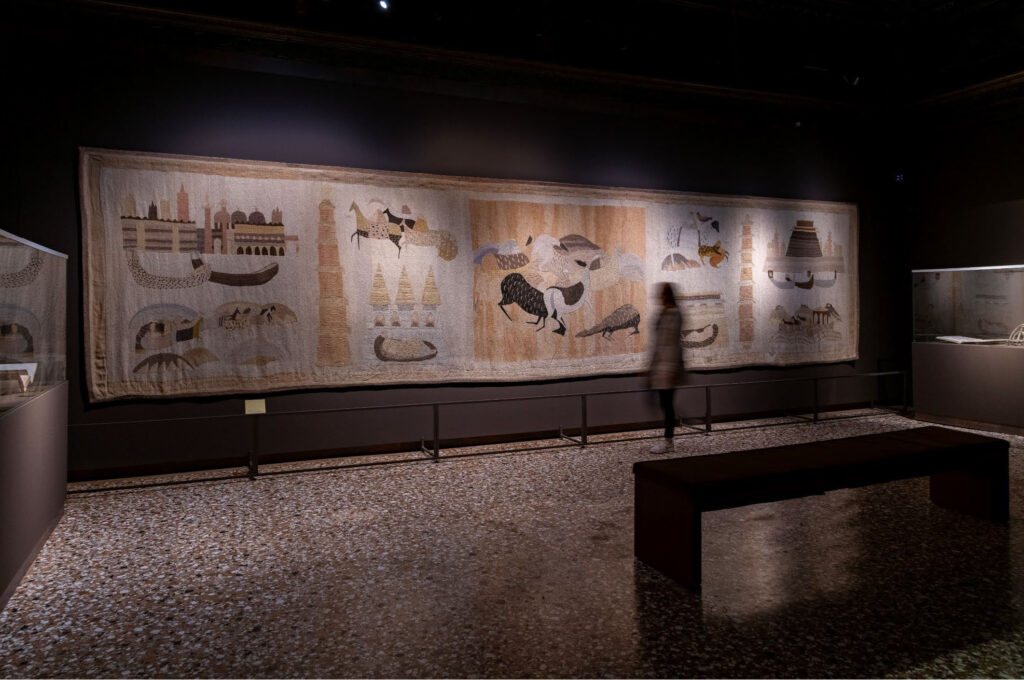
Exhibition room at the Doge’s Palace in Venice. (© Photo: Irene Fanizza, 2024).
The journey starts in Venice and specifically at the Polo house in San Giovanni Crisostomo, located in the sotoportego, corte seconda, ponte del Milion, showcasing unpublished discoveries from excavations around the area. These provide a clearer picture of the Polo family’s home and warehouse. The narrative expands to encompass Venice’s cosmopolitan essence and its inhabitants, whose livelihoods depended on travel. This narrative unfolds through cartographic explorations and the grand decorations of the Sala dello Scudo in the Doge’s Apartments, which highlight not only Venice’s possessions but also the far-flung regions explored by Venetians and the Polo family.
The exhibition delves deeper into Polo’s life and writings, showcasing his will and artefacts from his era such as coins, fabrics, ceramics, and spices, all of which he frequently mentioned in his accounts. It also explores the legend and literary significance of his twenty-year odyssey, which resulted in the book stemming from his encounter with Rustichello da Pisa in a Genoese prison and Polo’s own remarkable memory, intertwined with the richness of the writing.
A pivotal section of the exhibition focuses on Il Milione consigning the life of an ordinary Venetian merchant to history, fame, and immortality. A text that has proliferated in translations and different versions, a sort of travel guide with tips and curiosities ante litteram and a model for later famous literary works, from Jules Verne’s Journey to the Centre of the Earth to Italo Calvino’s Invisible Cities.
These are just a few of the tributes, homages and examples of critical fortune that followed Il Milione and Marco Polo throughout the XIXth and XXth centuries, a fame that continued through the decades with revisitations in a pop style, a source of inspiration for modern and contemporary artists, as displayed in the exhibition.
Display cases at the exhibition in the Doge’s Palace, Venice. (© Photo: Irene Fanizza, 2024).
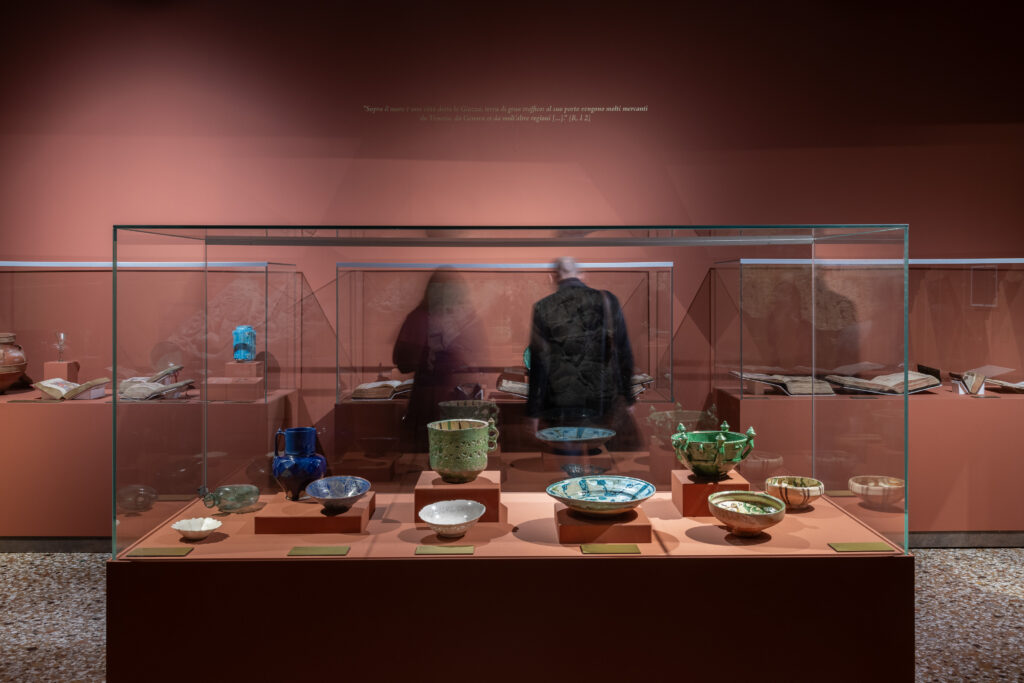
Last but not least, the exhibition intends to recall, once again, the value of the cultural inclusiveness of the journey, its openness, curiosity towards what is other than us, starting from the teaching of a young Venetian and his desire for knowledge. Respectful of what he saw in the world, he wrote of the people, cultures, different faiths, and religious cults he encountered, telling of Christian populations in their various declinations, of the cult and mysticism of Islam, of the Confucian Chinese, Buddhists, Taoists, of Hinduism in India.
HEAD IMAGE | The house of Marco Polo’s family in Venice, Corte del Milion. (© Matteo de Fina, 2024).